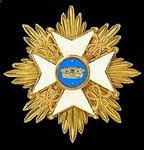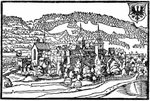The regiment was called Lenck from 1714-1734 then Appelgrehn 1734-1742; the earlier flags were carried by both. From 1760 the more elaborate flags were carried by Royal Suedois to 1791. There is some disagreement about the Colonel's flag of the early version; the 1721 MS shows it without fleur de lys as I have depicted it. The 1757 MS shows the pattern of blue and white stripes on the post-1760 flag differently from most modern versions, and I have followed that depiction for my version. These things are often disputed!
First raised 1690. In various actions of the Nine Years War (1688-1697).
In 1701 increased to two battalions. War of the Spanish Succession: 1702: Combat of Nijmegen. 1706: Battle of Ramillies; Defence of Menin. 1708: Battle of Oudenarde. 1709: Battle of Malplaquet. 1711 Attack on Arleux. 1712: Recapture of Douai, Le Quesnoy and Bouchain. 1713: Sieges of Landau and Freiburg.
Reduced to one battalion in 1714.
War of the Polish Succession: 1733 increased to three battalions. 1734: Capture of Trier, Trarbach and Philipsbourg. 1735: Battle of Klausen.
1737: Reduced to one battalion again.
War of the Austrian Succession: 1741 increased to two battalions. 1742: Invasion of Bohemia including the Combat of Sahay and defence of Prague. Given the name Royal Suedois in 1742 in recognition of its performance in the siege of Prague. 1743: In Bavaria and defence of Eger. 1744: Recapture of Wissembourg and the Lines of the Lauter, Combat of Augenheim and the attack on Donauworth. 1745: Combat of Pfeffenhoffen. 1746: Battle of Rocoux. 1746 November increased to four battalions. 1748: Siege of Maastricht. 1748 December reduced to three battalions.
From Susane (my edited translation):
In the SYW:
In 1756 the regiment took part in the camp of Dunkirk, which it left the following year to head to Germany. It arrived at Cologne on the 16th April, and was distinguished in the battle of Hastenbeck. Lieutenant Dahastierna was killed there and Captain Dalhielm wounded. It then went with Richelieu to Hanover and contributed to the capture of Minden and Hanover. The same year it provided the piquets which entered Harbourg and contributed to the fine defence made by the Marquis de Péreuse. Returning to the Rhine at the beginning of 1758, it took part with Vaubecourt in the combat of Alpen on the 12th June, near the canal of Rheinfeld.
The regiment fought with some distinction at the battle of Bergen in 1759. On the eve of the battle, on the 12th April, it had been placed in the orchards behind Bergen and it withstood the first attack of the enemy, which penetrated into the street of the village. In 1760 at Korbach the regiment was one of the units which was most heavily engaged. It was then under the command of the Count of Saint-Germain and remained under his command until the peace. It had been increased to three battalions on the 18th January 1760 by incorporating the regiment of Royal-Pologne. The Ordonnance of 21st December 1762 reduced it to two battalions. On re-entering Germany the regiment was put into garrison at Huningue. It was sent to Fort Louis in May 1763.
Uniform plate to follow.



















